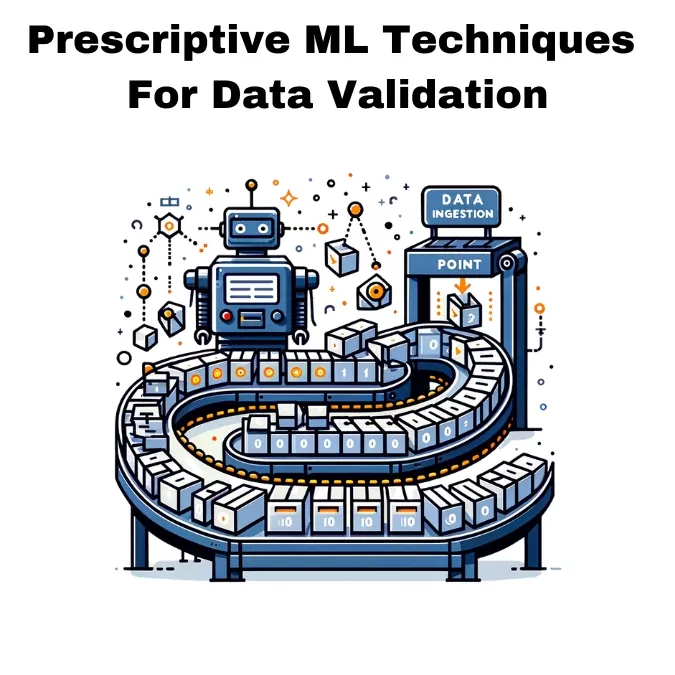Prescriptive ML-techniques for data validation
In an era where data is deemed the new oil, the significance of data validation, a process ensuring data accuracy and reliability, is paramount. Machine Learning (ML) emerges as a transformative force in this context, automating and enhancing data validation processes with its predictive and decision-making capabilities.

In an age where data is deemed the new oil, the importance of data validation can’t be overstated. Data validation is the process of ensuring that the data collected is accurate, reliable, and fits the intended purpose. However, traditional data validation methods often fall short, especially as the volume of data continues to skyrocket.
Here’s where Machine Learning (ML), with its ability to learn from and make predictions or decisions based on data, becomes a game-changer in automating and enhancing data validation processes.
Reaping the benefits of Machine Learning-powered data validation
Machine Learning, through its algorithms, can learn from the data and identify errors, inconsistencies, or anomalies swiftly and effectively. Unlike the traditional manual methods, ML algorithms can comb through vast datasets, identifying issues that might go unnoticed.
Integrating Machine Learning in data validation processes bears several advantages:
- Efficiency: Automating the validation process significantly accelerates the validation, saving precious time for other vital tasks.
- Accuracy: ML can uncover complex errors that might be missed by manual validation.
- Scalability: As the volume of data grows, ML can effortlessly scale to manage the increase without escalating validation time or cost.
Integrating machine learning into data validation processes opens up a realm of benefits. Here’s a deeper dive into these advantages, along with practical examples using popular open-source libraries:
Efficient anomaly detection with TensorFlow Data Validation (TFDV)
TensorFlow Data Validation is designed to fit into your data pipeline seamlessly. It helps in detecting anomalies by comparing new data against a standard schema.
Here’s how you can do it:
Let’s say you have a CSV file with daily sales data. You want to ensure that the data you receive daily follows the same pattern as your historical data.
import tensorflow_data_validation as tfdv
# Assume 'historical_sales.csv' is your historical data
historical_stats = tfdv.generate_statistics_from_csv('historical_sales.csv')
historical_schema = tfdv.infer_schema(statistics=historical_stats)
# Now 'daily_sales.csv' is the new data you want to check
daily_stats = tfdv.generate_statistics_from_csv('daily_sales.csv')
anomalies = tfdv.validate_statistics(statistics=daily_stats, schema=historical_schema)
# Display anomalies to see if there's anything unusual in daily sales
tfdv.display_anomalies(anomalies)In this example, tfdv.generate_statistics_from_csv computes summary statistics, and tfdv.validate_statistics checks for discrepancies. If the daily sales data deviate from the usual pattern, TFDV will let you know.
Outlier detection with Scikit-learn
Scikit-learn provides various tools for detecting outliers, which are data points that deviate significantly from the rest of the data.
Imagine you have a list of customer transaction amounts, and you want to find transactions that are unusually high or low, which could indicate errors or fraud.
For an in-depth exploration of Python tools that can enhance your data quality efforts, don’t miss our guide on ‘8 Essential Python Libraries for Mastering Data Quality Checks‘
from sklearn.ensemble import IsolationForest
import pandas as pd
# Load your transaction data
transactions = pd.read_csv('transactions.csv')
# Initialize the IsolationForest model
iso_forest = IsolationForest(n_estimators=100, contamination='auto')
# Fit the model to your data
iso_forest.fit(transactions[['amount']])
# Detect anomalies in the dataset
transactions['outlier'] = iso_forest.predict(transactions[['amount']])
# Filter and view the outliers
outliers = transactions[transactions['outlier'] == -1]
print(outliers)Here, IsolationForest helps to isolate and flag the unusual transactions. Transactions marked as -1 are the outliers you might need to investigate.
Streamlined data assessment with pandas profiling
Pandas Profiling is an open-source Python library that can be particularly useful for quick and efficient data validation. It generates detailed exploratory data analysis reports from a DataFrame. With just a few lines of code, you can create a report that provides insights into data distribution, missing values, correlation between variables, and more. It’s a valuable tool for identifying inconsistencies and validating the quality of your dataset at an early stage.
Here’s a simple example of how you can use Pandas Profiling to assess your data:
import pandas as pd
from pandas_profiling import ProfileReport
# Load your dataset
df = pd.read_csv('your_data.csv')
# Generate the profile report
profile = ProfileReport(df, title='Pandas Profiling Report', explorative=True)
# Save the report
profile.to_file("your_data_report.html")
By running this code, you produce an HTML report that gives you a visual and statistical understanding of your data’s condition, which is a critical step in ensuring data validation.
If you’re looking to deepen your understanding of the application of Pandas for data quality, our blog post ‘9 Data Quality Checks You Can Do with Pandas‘ is an essential read.
Recognizing the boundaries of Machine Learning in data validation
In the pursuit for data quality, Machine Learning (ML) stands out as a powerful ally. Yet, it’s not without its constraints. One such constraint is the dependency on human expertise. ML algorithms require thorough training, which means a deep dive into the data is necessary to set up the right conditions for validation. This process can be quite laborious, as it often demands a significant investment of time and expertise to get right.
Moreover, the nature of ML-based data validation relies heavily on the rules established by users. These rules are a product of anticipation—predicting potential data issues and creating safeguards against them. But what if we miss something? The truth is, no matter how exhaustive the rules, they may never cover the full spectrum of data quality challenges. This is where the promise of ML can hit a ceiling.
Up your data validation game with Telmai

As businesses evolve, their data validation needs to scale accordingly. That’s where Telmai rises to the occasion with its advanced data observability platform, surpassing traditional ML-based validation tools. It streamlines data quality management, removing the need for intricate coding or extensive datasets.
With Telmai, you’re not just reacting to data quality issues—you’re proactively preventing them. Telmai learns from your data and alerts you to anomalies in real time. This proactive approach ensures that potential issues are flagged before they become problematic, saving time and resources.
Telmai’s user-friendly interface allows teams to maintain a clear oversight of data health, with advanced analytics and visualization tools that simplify the diagnosis and resolution of data issues. Telmai offers a wide range of integrations that would allow you to monitor your data in real time anywhere from ingest to downstream systems and everything in between.
Don’t just manage your data quality; master it with Telmai. Request a demo today to experience the transformative power of data observability.
Passionate about data quality? Get expert insights and guides delivered straight to your inbox – click here to subscribe to our newsletter now.
- On this page
See what’s possible with Telmai
Request a demo to see the full power of Telmai’s data observability tool for yourself.
